| 1 June |
• yesterday • tomorrow |
| Memorial of Saint Justin, Martyr |

• Justin the Philosopher
• Justin of Nablus
Pagan philosopher who converted to Christianity at age 30 by reading the Scriptures and witnessing the heroism and faith of martyrs. He used his philosophical and oratorical skills to publicly dispute with pagans and explain his new faith, and he became one of the first great Christian apologists. He later opened a school of public debate in Rome, Italy. All this high profile Christianity naturally brought him to the attention of the authorities, and he died a martyr.
c.100 at Flavia Neapolis, Judaea province, Roman Empire (modern Nablus, Palestine)
• beheaded in 165 at Rome, Italy
• relics in the Capuchin church, Rome
• apologists
• lecturers, orators, speakers
• philosophers
• ax
• pen
• sword
• Lumen Verum Apologetics
• The First Apology - librivox audiobok
• The Second Apology - librivox audiobook
As by the Word of God, Jesus our Savior was made Flesh and had both Flesh and Blood for our salvation, so also the food which has been blessed by the word of the prayer instituted by Him is both the Flesh and Blood of Jesus Incarnate. - Saint Justin Martyr
The saints were seized and brought before the prefect of Rome, whose name was Rusticus. As they stood before the judgment seat, Rusticus the prefect said to Justin, "Above all, have faith in the gods and obey the emperors." Justin replied, "We cannot be accused or condemned for obeying the commands of our Savior, Jesus Christ." Rusticus said, "What system of teaching do you profess?" Justin said, "I have tried to learn about every system, but I have accepted the true doctrines of the Christians, though these are not approved by those who are held fast by error." The prefect Rusticus said, "Are those doctrines approved by you, wretch that you are?" Justin said, "Yes, for I follow them with their correct teaching." The prefect Rusticus said, "What sort of teaching is that?" Justin said, "Worship the God of the Christians. We hold him to be from the beginning the one creator and maker of the whole creation, of things seen and things unseen. We worship also the Lord Jesus Christ, the Son of God." Rusticus said, "You are a Christian, then?" Justin said, "Yes, I am a Christian." The prefect said to Justin, "You are called a learned man and think you know what is true teaching. Listen: if you were scourged and beheaded, are you convinced that you would go up to heaven?" Justin said, "I hope that I shall enter God's house if I suffer in that way. For I know that God's favor is stored up until the end of the whole world for all who have lived good lives." The prefect Rusticus said, "Do you have an idea that you will go up to heaven to receive some suitable rewards?" Justin said, "It is not an idea that I have; it is something I know well and hold to be most certain." The prefect Rusticus said, "Now let us come to the point at issue, which is necessary and urgent. Gather round then and with one accord offer sacrifice to the gods." Justin said, "No one who is right-thinking stoops from true worship to false worship." The prefect Rusticus said, "If you do not do as you are commanded you will be tortured without mercy." Justin said, "We hope to suffer torment for the sake of our Lord Jesus Christ, and so be saved." In the same way the other martyrs also said, "Do what you will. We are Christians; we do not offer sacrifice to idols." The prefect Rusticus pronounced sentence, saying, "Let those who have refused to sacrifice to the gods and to obey the command of the emperor be scourged and led away to suffer capital punishment according to the ruling of the laws." Glorifying God, the holy martyrs were beheaded, and so fulfilled their witness of martyrdom in confessing their faith in their Savior. - from the Acts of the Martyrdom of Saint Justin and his Companions
Through Christ we received new life and we consecrated ourselves to God. I will explain the way in which we did this. Those who believe what we teach is true and who give assurance of their ability to live according to that teaching are taught to ask God's forgiveness for their sins by prayer and fasting and we pray and fast with them. We then lead them to a place where there is water and they are reborn in the same way as we were reborn; that is to say, they are washed in the water in the name of God, the Father and Lord of the whole universe, of our Savior Jesus Christ and of the Holy Spirit. This is done because Christ said: Unless you are born again you will not enter the kingdom of heaven, and it is impossible for anyone, having once been born, to reenter his mother's womb. An explanation of how repentant sinners are to be freed from their sins is given through the prophet Isaiah in the words: Wash yourselves and be clean. Remove the evil from your souls; learn to do what is right. Be just to the orphan, vindicate the widow. Come, let us reason together, says the Lord. If your sins are like scarlet, I will make them white as wool; if they are like crimson, I will make them white as snow. But if you do not heed me, you shall be devoured by the sword. The mouth of the Lord has spoken. The apostles taught us the reason for this ceremony of ours. Our first birth took place without our knowledge or consent because our parents came together, and we grew up in the midst of wickedness. So if we were not to remain children of necessity and ignorance, we needed a new birth of which we ourselves would be conscious, and which would be the result of our own free choice. We needed, too, to have our sins forgiven. This is why the name of God, the Father and Lord of the whole universe, is pronounced in the water over anyone who chooses to be born again and who has repented of his sins. The person who leads the candidate for baptism to the font calls upon God by this name alone, for God so far surpasses our powers of description that no one can really give a name to him. Anyone who dares to say that he can must be hopelessly insane. This baptism is called "illumination" because of the mental enlightenment that is experienced by those who learn these things. The person receiving this enlightenment is also baptized in the name of Jesus Christ, who was crucified under Pontius Pilate, and in the name of the Holy Spirit, who through the prophets foretold everything concerning Jesus. - from the first apology in defense of the Christians by Saint Justin, martyr
https://catholicsaints.info/saint-justin-martyr/
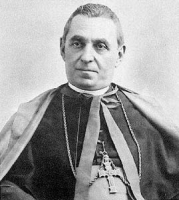
• John Baptist Scalabrini
• Apostle of the Catechism
• Father of Migrants
Third of eight children in a deeply religious family. Studied philosophy and theology at the seminary at Como, Italy. Ordained on 30 May 1863. Professor and rector of Saint Abundius Seminary. Pastor of Saint Bartholomew's Church in 1870. Bishop of Piacenza, Italy on 30 January 1876 at age 36.
Conducted diocesan visitation five times, visiting all 365 parishes, half of which could only be reached by foot or mule. Celebrated three Synods, one of which was dedicated to the Eucharist. Encouraged frequent Communion and perpetual adoration. Reorganized seminaries and reformed their curricula, anticipating the Thomistic reform of Pope Leo XIII. Preacher, teaching always to love the Pope and the Church.
Worked with cholera victims, visited the sick and prisoners, helped the poor and bankrupt nobility. Saved thousands of farmers and workers from famine, selling his horse, chalice, and the pectoral cross that Blessed Pope Pius IX had given him in order to buy food. Founded an institute to help hearing and speech-impaired women. Organized assistance for young single women employed in rice fields. Established mutual aid societies, workers' associations, rural banks, cooperatives, and Catholic Action groups. Ordered that catechism be taught in all parishes. Planned and presided over the first National Catechetical Congress in 1889.
He was convinced that devotion to religion and one's country could be reconciled in the hearts of Italians. Promoted reconciliation between Church and State, and helped solve a painful moral dilemma for Italian Catholics. He aimed at preparing this religious reconciliation on a practical level, combining religious belief and patriotic love in his work with migrants. Worked with millions of Italians forced to emigrate, often in dire conditions, always in danger of losing their faith and their attachment to religious practice.
With the approval of Pope Leo XIII, on 28 November 1887 he founded the Congregation of the Missionaries of Saint Charles (Scalabrinians) for religious, moral, social and legal care of migrants. Convinced Saint Frances Xavier Cabrini, the Mother of Migrants, to leave for America in 1889 to care for children, orphans and sick Italian migrants. In 1895 founded the Congregation of the Missionary Sisters of Saint Charles for migrants. Even the sister Apostles of the Sacred Heart of Jesus were encouraged to care for migrants. His spirituality and his love for migrants inspired the Scalabrinian Lay Missionary Women.
John was devoted to the Eucharist and spent hours in adoration before the Blessed Sacrament, to Our Lady, preaching many Marian homilies, and making Marian pilgrimages. His last conscious words were, "Lord, I am ready, Let us go".
8 July 1839 at Fino Mornasco, Como, Italy
• dawn on the feast of the Ascension of the Lord, 1 June 1905 in Piacenza, Italy of natural causes
• on 13 April 2013 a ring, a chalice, and his pectoral cross were stolen from the tomb; the thieves have apparently been caught, but the relics not recovered
9 October 2022 by Pope Francis
Scalabrinians
Lord, I am read, let us go. - Saint Giovanni's last words
The Catholic Church is called by its divine apostolate and by its age-old tradition to make its imprint on the great social movement of migration, whose goal is economic recovery and the merging of Christian peoples. - Blessed John Scalabrini, memorandum, 1905
He who lives from faith not only loves God, but feels impelled to make others love him. Hence the fever of saints to sacrifice their whole selves for the salvation of souls. And hence those wonders of charity and zeal that we read about in their lives and that call forth the admiration of every age. The zeal of God's glory consumed them, never letting them rest for a single instant. - Blessed John Scalabrini, Pastoral Letter of 1877
The spirit, the character, the sole ambition of the bishop lies in sacrificing himself in every way to spread the kingdom of Jesus Christ in people's souls, risking, if necessary, his own life for the salvation of his beloved flock, placing himself, so to speak, on his knees before all the people in order to beseech the favor of their permission to do them good. He uses everything - his whole authority, skill, health, strength - for this noblest of purposes. - Blessed John Scalabrini
https://catholicsaints.info/saint-john-baptist-scalabrini/
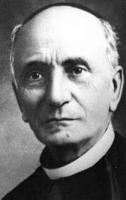
• Annibale Maria di Francia
• Hannibal di Francia
Third of four children of Francis the Marquises of Saint Catherine of Jonio, a Papal Vice-Consul, a knight, and Honorary Captain of the Navy; his mother was Anna Toscano, an Italian aristocrat. His father died when Hannibal was fifteen months old. The boy developed a devotion to the Eucharist and the Virgin Mary. At age 17, while in prayer before the Blessed Sacrament, he received a call to religious life. Ordained 16 March 1878. Immediately after he moved into the Avignone ghetto, one the most impoverished areas he could find, and began a life's work with the poor. In 1882 he founded the Anthonian Orphanages, so-called because they were under the patronage of Saint Anthony of Padua; they were noted for their operation as an extended family. In order to expand this work to a much larger sphere of physically and spiritually poor he founded The Daughters of Divine Zeal in 1887, and The Rogationists in 1897; they were canonically approved on 6 August 1926. He believed in the need for a strong priesthood; he started the Holy Alliance and Pious Union of the Evangelical Rogation, worldwide movements of prayer for vocations, and published the periodical God and Neighbor with information about these movements and their work. He worked to be a model for the seminarians who came to work in his schools, and cared for the physical and spiritual needs of his brothers and sisters in the religious life. He was considered a saint during his life, and received a vision of the Virgin Mary just before his death. The groups he founded continue to day, working all over the world in prayer, publishing, orphanages, schools, training for the deaf and mute, care for the aged, home for single mothers, and schools of all types.
5 July 1851 at Messina, Italy
1 June 1927 at Messina, Italy of natural causes
16 May 2004 by Pope John Paul II
What are these few orphans we attend to, these few people we bring the good news to, compared to the millions who are lost and abandoned as sheep without a shepherd? I looked for an answer and I found a complete one in the words of Jesus: 'Ask the Lord of the harvest to send out laborers to gather his harvest'. I concluded then that I had found the secret key to all good works and to the salvation of all souls". - Saint Hannibal
From my early youth I have committed myself to that Holy Word of the Gospel: 'Rogate ergo...' From my small Institutes an unceasing daily prayer is raised by the orphans, the poor, the priests and the consecrated virgins, to the most Sacred Hearts of Jesus and Mary, to Saint Joseph and the Apostles, that they may abundantly provide the Church with holy and chosen priests and with evangelical workers for the spiritual harvest of souls. - Saint Hannibal, writing to the Vatican about his proposed congregations
The entire Church must formally pray for [vocations] because the purpose of the prayer to gain vocations must concern all the faithful, every Christian who has at heart the good of souls and, in a particular way, the Bishops who are the shepherds of the spiritual flock and to whom souls are entrusted. They are the living Apostles of Jesus Christ today. - Saint Hannibal
https://catholicsaints.info/saint-hannibal-mary-di-francia/

• Theobald of Vico
• Theobald of Alba
• Theobald Roggeris
1 February (part of the miracle of the bells at the discovery of his relics)
Born to a wealthy, noble Piedmont family, his reading of the Gospel caused him to abandon position for a simple life. Cobbler in Alba, Italy. Theobald proved himself a skillful craftsman, and his master hoped that the young apprentice would marry his daughter and carry on the business. Theobald, however, had made a private vow of chastity, and abandoned the trade. Following a pilgrimage to Compostela, Spain, he worked as a porter, spending his day carrying sacks of grain. He gave away as much of his wages as he could to people even more poor than himself, and there are ballads about him in which he gave away the grain and flour he was supposed to deliver. Venerated in Liguria and the Piedmont regions.
late 11th century in Vico, Liguria, Piedmont, Italy
• 1150 of natural causes
• at his request, Theobald was buried in a patch of ground between the church of San Lorenzo and the church of San Silvestro
• his grave became a place of pilgrimage and healing miracles, but afater many decades faded into obscurity and its location was lost
• relics re-discovered late in the evening of 31 January 1429 by the bishop of Alba, Italy; legend says the church bells of all the area churches rang on their own at sun-up the following day in celebration
• relics enshrined in a chapel in the cathedral of Alba
1841 by Pope Gregory XVI (cultus confirmation)
• against fever
• against sterility
• church cleaners
• cobblers, shoemakers
• porters
pilgrim with cobblers's tools
https://catholicsaints.info/blessed-theobald-roggeri/
1 December as one of the Martyrs of Oxford University
Educated at Oxford. Doctor of law. President of Broadgate Hall (modern Pembroke College) form 1537 to 1539. First Regius Professor of civil law. Married in 1547.
Member of the English Parliament in 1547. Opposed anti-Catholic laws enacted by King Edward VI. Imprisoned from 1548 to 1550 for opposed the Bill of Uniformity.
On his release, he and his family moved to Leuven, Belgium, but returned to England in August 1553 when Catholic Queen Mary ascended to the throne. Chancellor to Bishop Edmund Bonner. Member of Parliament again from 1553 to 1560. In 1560 he opposed the Bill of Supremacy, and incurred the ire of Queen Elizabeth. Imprisoned in Fleet Prison on 20 May 1560, he escaped, was captured at Marshalsea, and re-imprisoned.
Escaping again, he fled the country to Antwerp, Belgium. There he renounced his English citizenship, and became a subject of the Catholic Spanish crown. Customs official in Flanders.
Kidnapped at Bergen-op-Zoon by agents of Queen Elizabeth in August 1570. Returned to England, he was locked in the Tower of London and repeatedly tortured. Indicted on 26 May 1571 for conspiring against the Queen's life. Throughout his misery, John claimed his innocence, and the court's lack of jurisdiction over him, a Spanish subject. Condemned on 27 May 1571. Martyr.
1504 in northern England
hanged, drawn, and quartered on 1 June 1571 at Tyburn, England
29 December 1886 by Pope Leo XIII (cultus confirmed)
https://catholicsaints.info/blessed-john-storey/
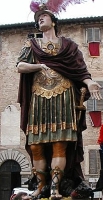
• Crescentinus di Città di Castello
• Crescentian, Crescentino, Crescenziano, Crescentianus
Imperial Roman soldier. Convert to Christianity. During the persecutions of Diocletian, Crescentinus fled to Thifernum Tiberinum (modern Città di Castello). There he is reported to have slain a dragon that had terrorized the region; this convinced the locals of the power of God and led to many conversions, and to the depictions of Crescentinus fighting a dragon. It is also possible that Crescentinus evangelized the region, made many converts, and the image of him slaying the dragon is represents him defeating the devil or paganism. Eventually, however, the anti-Catholic forces of Diocletian came to the area, and Crescentinus fell as a martyr.
• beheaded on 1 June 303 at Saldo, Italy
• relics translated to Urbino, Italy in 1068 by Blessed Mainard of Urbino
• against headache (a ceremony in Urbino cures headaches by tapping the sufferer's head with the relics of Crescentinus)
• Città di Castello, Italy
• Urbino, Italy
• Roman soldier
• slaying a dragon, generally from horseback
https://catholicsaints.info/saint-crescentinus/
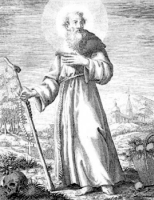
• John Pelino Goto
• Giovanni Pelino Goto
Son of a wealthy merchant, John cared nothing for business, wealth or worldly success and preferred to live as a hermit. He eventually felt a call to help the poor and sick in the world, and gave away food, clothes and wealth, going hungry, living in rags, wearing a rope around his neck to indicate that he was a sinner in need of punishment, and falling into lengthy ecstasy. His family worried about his health, both physical and mental, and they had to bring him in from the street. He became a Franciscan tertiary, and with the support and discipline they provided, he was able to properly devote his life to prayer and charity.
1240 at Urbino, Italy
• 1 June 1304 in Urbino, Italy
• buried in the cloister cemetery at the San Francesco monastery, Urbino
• many miracles reported at his grave
• re-interred in the church at the cloister
13 November 1918 by Pope Benedict XV (cultus confirmed)
https://catholicsaints.info/blessed-john-pelingotto/

• Clarus of Albi
• Clarus of Lactoræ
• Clarus of Lectoure
• Chiaro, Clair, Clar
• 28 May (translation of relics to Tulle, France)
• 29 May (translation of relics to Puy, France)
Priest who emigrated from north Africa to Italy in the late 1st century, was consecrated as a bishop, and became a travelling preacher in the Aquitaine region. Bishop of Albi, France for three years. While preaching in Lactoræ, Novempopulania, Chiaro was ordered to honour an idol; he knocked it off its pedestal. Martyr.
• beheaded in the early 2nd century in Lectoure, France
• some relics enshrined in Albi, France
• some relics enshrined in Lectoure, France
• some relics enshrined in Tulle, France
• some relics enshrined in Bordeaux, France
• some relics enshrined in Limoges, France
eyes; against eye problem (in Cologne-du-Gers, France)
https://catholicsaints.info/saint-clarus-of-aquitaine/
• Simeon of Trier
• Symeon, Simeone
His father was Greek, his mother Calabrian. Educated in Constantinople. Pilgrim to the Holy Lands where he supported himself by serving as tour guide to other pilgrims. Spoke Greek, Latin, Coptic, Syriac and Arabic. Monk in Bethlehem. Deacon. Hermit beside the River Jordan. Monk in Bethlehem. Hermit on Mount Sinai. Sent to seek alms from the Duke of Normandy for the support of other hermits on the mountain. Hermit near Trier, Germany under the direction of the abbot of the nearby Benedictine monastery of Saint Martin. One of the last great figures linking the Orthodox West with the Orthodox East.
in Syracuse, Sicily
• in 1035 in Trier, Germany of natural causes
• buried in his hermitage
• a collegiate church was built in the nearby city wall's gate, known as the Porta Nigra, and his relics were enshrined there in 1037
• church destroyed and relics lost during a construction project in 1804
1042 by Pope Benedict IX
https://catholicsaints.info/saint-simeon-of-syracuse/
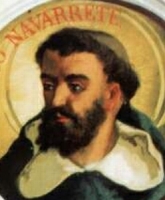
• Alfonsus Navarrete
• Alphonso Navarrete
• Alphonsus de Mena
• 10 September (as one of the 205 Martyrs of Japan)
• 6 November (Dominicans as one of their Martyrs of the Far East)
Dominican priest. Missionary to the Philippines in 1578. In 1610 he returned to Europe to recruit missionaries, and in 1611 returned to the Orient as missionary and Dominican provincial vicar in Japan. His evangelism work brought many hundreds to Christianity. Martyr.
21 September 1571 in Logroño, Spain
beheaded on 1 June 1617 in Koguchi, Omura, Nagasaki, Japan
7 May 1867 by Blessed Pope Pius IX
https://catholicsaints.info/blessed-alfonso-navarrete-benito/
Gaudentius Auxerensis
Bishop of Ossero, Istria (in modern Croatia) in 1030. Falsely accused by some of the nobility who objected to his spiritual reforms, Guadentius travelled to Rome, Italy in 1032 to defend his name. On the way home, he fell ill in Ancona, and stayed there to recover. He then resigned his see, and became a Benedictine monk under Saint Peter Damian.
in Trzic, Istria (in modern Croatia)
• 31 May 1044 in Ancona, Italy of natural causes
• legend says that on 31 May 1144, a century to the day after his death, the relics of Gaudentius, stored in an iron-bound chest, floated ashore in Osor, Croatia as all the church bells rang by themselves
• relics in the Church of Saint Guadentius, Osor, Croatia
• Osor, Croatia
• Cres, Croatia
https://catholicsaints.info/saint-gaudentius-of-ossero/

• Wystan of Mercia
• Vistano, Wigstan, Wigstow, Winston, Wistan, Wistanstow, Wistow
Prince of Mercia, the son of Wigmund of Mercia and Aelfflaed, daughter of King Ceolwulf I of Mercia. Killed in his youth by his regent Bertulph, king of Mercia, for opposing the marriage of Bertulph to Wistan's mother. Some writers have considered him a martyrs.
• murdered on 1 June 849 at Wistanstow, England
• buried in Repton Abbey, Derbyshire, England
• miracles reported at his tomb
• relics translated to the Evesham Abbey, and then the Evesham cathedral
• Evesham, England
• Repton, England
Saxon prince leaning on a sword
https://catholicsaints.info/saint-wystan-of-evesham/
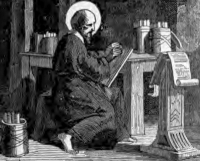
Studied in Berytus, Phoenicia and in Alexandria, Egypt. Careful student of the works of Origen. Priest, ordained at Caesarea. Head of a catechetical school in Caesarea. Noted Bible scholar. In a day when books were hand-copied, Pamphilus was known for the size of his library which survived until destroyed by Arabs in the 7th century. Teacher of the noted historian Eusebius of Caesarea, helped him write an Apology of Origen, and was the subject of a biography by Eusebius. Arrested in 308 by governor Urban for the crime of being a Christian. One of a group of martyrs who were tortured and murdered together.
Berytus, Phoenicia
beheaded in 309 in Alexandria, Egypt
https://catholicsaints.info/saint-pamphilus-of-alexandria/
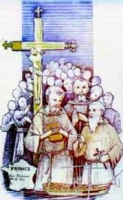
Priest in the diocese of Moulins, France. Canon of Moulins. During the French Revolution he was arrested and sentenced to forced labour for the crime of being a priest. Imprisoned on a ship anchored off shore, he was tortured repeatedly, starved and left to die. One of the Martyrs of the Hulks of Rochefort.
17 November 1736 in Molins, Allier, France
1 June 1794 aboard the prison galley Deux-Associés in port at Rochefort, Charente-Maritime, France of general abuse and neglect
1 October 1995 by Pope John Paul II
https://catholicsaints.info/blessed-jean-baptiste-ignace-pierre-vernoy-de-montjournal/
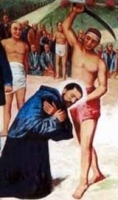
• Ferdinand of Saint Joseph Ayala
• Fernando Ayala
• Fernando of Saint Joseph
• Hernando Ayala
• Hernando of Saint Joseph
28 September as one of the Augustinian Martyrs of Japan
Augustinian priest in 1603. Missionary to Mexico. Missionary to Japan. Augustinian vicar provincial in 1605. Worked with Blessed Alphonsus Navarette. Martyr.
1575 in Ballesteros de Calatrava, Ciudad Real, Spain
beheaded on 1 June 1617 in Koguchi, Omura, Nagasaki, Japan
7 May 1867 by Pope Blessed Pius IX
https://catholicsaints.info/blessed-ferdinand-ayala/
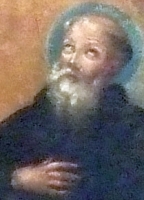
Eñeco, Eñecone
Hermit. Monk at San Juan de Peña, Aragon (part of modern Spain), and later served as prior. Hermit in the Aragon mountains. Reforming abbot at the monastery at Oña, Spain in 1029 at the request of King Sancho the Great. Known as a peacemaker and miracle worker.
11th century at Bilbao, Spain
• 1 June 1057 at the monastery at Oña, Spain of natural causes
• his holiness was so obvious to all that he was mourned by the Jews and Muslims of the city as well as the Christians
1259 by Pope Alexander IV
https://catholicsaints.info/saint-inigo-of-ona/
Medulfo, Mion
Married, a father, and a fervant Christian, Medulph one day went to gather food for the family. It was a fasting day, so Medulph went to the river to fish; but it was a cold day, too, and all the waterways were frozen, and he could catch no fish. Worried that the family would have to go hungry, Medulph went to a fountain to draw water; when he drew up the bucket, there was a large fish in it. Medulph fed his family with this miraculous meal, and moved even more in his faith from this intervention, he eventually became a hermit near Thiers, Auvergne, France.
• 1 June 430 of natural causes
• buried in the abbey of Menat, France
https://catholicsaints.info/saint-medulph-of-thiers/
Reverentianus, Reveriano, Reverie, Rivianus
Evangelizing bishop. Missionary to Gaul with Saint Paulus of Autun and ten companions whose names have not come down to us. Bishop of Autun, France, which formed the base of operations for the group. They were all martyred by order of Emperor Aurelian who was at war with the locals at the time.
3rd century Italy
• beheaded c.273 in Autun, France
• buried in Autun
• a monastery and church grew up around the group's grave site
• oil reported to flow from his relics and grave
• head in the church in Nuits, France; no other relics have survived
https://catholicsaints.info/saint-reverianus-of-autun/
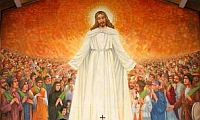
Joseph Tuc
24 November as one of the Martyrs of Vietnam
Christian peasant farmer in the apostolic vicariate of Central Tonkin (modern Vietnam). During the persecutions of emperor Tu-Duc, he was ordered to step on a crucifix to show his contempt for Christianity; he refused. Imprisoned, tortured and executed. Martyr.
c.1843 in Hoàng Xá, Bac Ninh, Vietnam
beheaded on 1 June 1862 in Hoàng Xá, Bac Ninh, Vietnam
19 June 1988 by Pope John Paul II
https://catholicsaints.info/saint-giuse-tuc/
• Conrad of Herlesheim
• Conrad of Haina
• Conrad of Hessen
• Konrad...
Conrad's father, also named Conrad, died in a shipwreck before the boy was born. Well-educated, Conrad was drawn to religious life, and became a Cistercian monk at the monastery in Haina, Germany around age 20. Priest. He served as sacristan and then cellar-master of his house for 16 years. Late in life he retired from all duties in the house to live in prayerful isolation.
c.1200 in Herlesheim, Upper Hesse, Germany
3 August 1270 of natural causes
https://catholicsaints.info/blessed-conrad-of-hesse/

• Ronan of Locronan
• Ronan of Quimper
• Ronan the Silent
• Renan, Ronanus, Ruadan, Rumon, Ruadhan, Ruan
An early missionary bishop, ordained by Saint Patrick, who preached in Cornwall, England, and in Brittany, France.
in Cornwall, England
• 6th century in Brittany (in modern France) of natural causes
• buried in Locronan, Brittany
• Laurenan, France
• Locronan, France
• Quimper, France
• Saint-Renan
https://catholicsaints.info/saint-ronan/
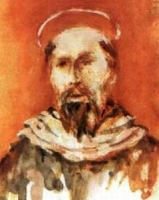
• Alonso de Mena Navarette
• Alonso de Mena Navarro
Nephew of Blessed Peter Paul Navarro. Entered the Dominican Order at Salamanca, Spain. Priest. Missionary to Japan. Martyr.
3 February 1568 in La Rioja, Logroño, Spain
burned alive on 10 September 1622 in Nishizaka, Nagasaki, Japan
7 May 1867 by Pope Blessed Pius IX
https://catholicsaints.info/blessed-alphonsus-de-mena/

Gwen, Hwitn, White, Whyte, Wite, Witt, Witta
Martyred by pagan Danes. There is a holy well devoted to her at nearby Morcombe Lake.
• in Dorset, England
• relics still exist in their shrine at Whitchurch Canonicorum, Dorset; believed to be the only relics in a parish church that survived the Protestant Reformation
https://catholicsaints.info/saint-candida-of-whitchurch/
Paul, Paolo
Evangelizing priest. Missionary to Gaul with Saint Reverianus of Autun and ten companions whose names have not come down to us. Worked from Autun, France. They were all martyred by order of Emperor Aurelian who was at war with the locals at the time.
3rd century Italy
• beheaded c.273 in Autun, France
• buried in Autun
• a monastery and church grew up around the group's grave site
https://catholicsaints.info/saint-paulus-of-autun/
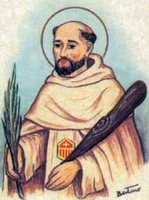
Mercedarian friar. Professor in a medical school in Montpellier, France. Preacher and writer who made expeditions to ransom Christians who had been enslaved by Muslims. During one of these trips he was imprisoned and beaten daily by Muslims for adhering to Christianity. Martyr.
14th century France
beaten to death in 1394 in Granada, Spain
https://catholicsaints.info/blessed-arnald-arench/
• Conrad of Treves
• Cuno...
Born to a noble Swabian family. Nephew of Saint Anno. Bishop of Trier, Germany, which involved him in the political fight over who had the right to choose the bishop of that diocese. On his way to Trier he was captured by opponents and murdered. Considered a martyr.
Swabia, Germany
thrown from a castle tower in 1066 at Uerzig, Germany
https://catholicsaints.info/saint-conrad-of-trier/

Caprais, Caprasio
Hermit in Provence and Lerins, France, and in Greece. Friend of Saint Honoratus of Arles and Saint Venantius. With Saint Honoratus, he founded a monastery at Lerins, and eventually served as its abbot.
430 of natural causes
Aulla, Italy
https://catholicsaints.info/saint-caprasius-of-lerins/
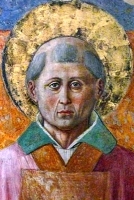
• Fortunatus of Territet
• Fortunato...
Fifth-century parish priest in the village of Territet near Spoleto, Italy. Famed for his love for the poor, his gentleness as a pastor, and as a miracle worker.
Montefalco, Italy
https://catholicsaints.info/saint-fortunatus-of-spoleto/
Ischirion, Ischirione
Steward and servant of an Alexandrian magistrate in Roman imperial Egypt. During the persecutions of Decius, Ischyrion's employer demanded that he renounce Christianity and sacrifice to pagan gods. When Ischyrion refused, the magistrate ordered him beaten and martyred.
Egyptian
impaled c.250 at Alexandria, Egypt
https://catholicsaints.info/saint-ischyrion/
• Leo Tanaca
• Leone...
10 September as one of the 205 Martyrs of Japan
Layman catechist in the Archdiocese of Nagasaki, Japan. Martyr.
c.1590 in Omi, Japan
beheaded on 1 June 1617 on a rock near Omura, Nagasaki, Japan
7 May 1867 by Pope Blessed Pius IX
https://catholicsaints.info/blessed-leo-tanaka/
Damianus
Two versions of his story exist:
1) He was a priest in Patras, Greece. With Saint Regulus of Scotland, he came to the west with the relics of Saint Andrew the Apostle.
2) He was a priest in Scotland who received Saint Regulus of Scotland and helped him enshrined the relics of Saint Andrew the Apostle.
https://catholicsaints.info/saint-damian-of-scotland/
Felino of Perugia
13 March (translation of relics in Arona, Italy)
Imperial Roman soldier. Martyred in the persecutions of Decius.
• c.250 at Perugia, Italy
• relics translated to Arona, Italy in 979
Arona, Italy
https://catholicsaints.info/saint-felinus-of-perugia/
Student of Saint Pamphilus of Alexandria; fellow student with Saint Porphyrius of Alexandria. Seleucus applauded how strong and calm Saint Porphyrius remained under torture; this exposed him as a Christian, and he was martyred.
Cappadocia
beheaded in 309 in Alexandria, Egypt
https://catholicsaints.info/saint-seleucus-of-alexandria/
Gratianus
13 March (translation of relics in Arona, Italy)
Imperial Roman soldier. Martyred in the persecutions of Decius.
• c.250 at Perugia, Italy
• relics translated to Arona, Italy in 979
https://catholicsaints.info/saint-gratian-of-perugia/
Caius
Born to Christian parents. Dominican tertiary. Helped the friars with their missionary work, and was martyred for it.
Japanese
17 August 1627 at Nagasaki, Japan
7 May 1867 by Pope Blessed Pius IX
https://catholicsaints.info/blessed-gaius-xeymon/
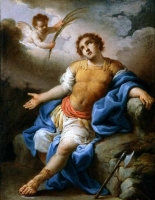
Procolo
An officer in the Imperial Roman army. Martyred in the persecutions of Diocletian.
crucified c.304 in Bologna, Italy
https://catholicsaints.info/saint-proculus-the-soldier/
Fermo
Martyr.
• Rome, Italy in the early days of the Church
• interred in the Roman catacombs
• relics transferred to the Discalced Carmelite convent of Saint Joseph in Vienna, Austria in mid-17th century
https://catholicsaints.info/saint-fermus-of-rome/
Agapitus
28 September (monastery fathers of Kiev-Pechersk)
Monk in Ruthenia (in modern Ukraine). Physician who did not charge for his services.
c.1100 of natural causes
https://catholicsaints.info/saint-agapetus-of-ruthenia/
Claudio
15th bishop of Vienne, France, serving from c.440 to c.449. Part of the Council of Orange in 441. Part of the Synod of Vaison in 442.
https://catholicsaints.info/saint-claudius-of-vienne/
Egole di Disert Eegoilse
No details about this saint have survived.
Irish
https://catholicsaints.info/saint-egole-of-the-eegoilse-desert/
Student of Saint Pamphilus of Alexandria with whom he was tortured and martyred.
beheaded in 309 in Alexandria, Egypt
https://catholicsaints.info/saint-porphyrius-of-alexandria/
Martyred in the persecutions of Emperor Alexander Severus.
230 in Cappadocia (in modern Turkey)
https://catholicsaints.info/saint-thespesius-of-cappadocia/
Benedictine monk at Ona, Old Castile, Spain. Spiritual student of Saint Enneco. Bishop of Oca-Valpuesta, Spain.
1044 of natural causes
https://catholicsaints.info/saint-atto-of-oca/
Martyr.
• Rome, Italy, date unknown
• relics translated to the Benedictine monastery at Chaise-Dieu, Evreux, France
https://catholicsaints.info/saint-juventius/
Martyred in the persecutions of Diocletian.
drowned in 304 in the River Tiber at Amelia, Italy
https://catholicsaints.info/saint-secundus-of-amelia/
Tegla, Thecla
The patron of a church and a healing well in Ciwyd, Wales.
https://catholicsaints.info/saint-telga-of-denbighshire/
Bishop of Bologna, Italy from 540 until his death. Martyred by Goths led by Goterne.
542
https://catholicsaints.info/saint-proculus-of-bologna/
Arnoldus
Carthusian monk in Capella, Belgium.
https://catholicsaints.info/blessed-arnold-of-geertruidenberg/
Monk in Ruthenia (in modern Ukraine).
c.1100 of natural causes
https://catholicsaints.info/saint-dionysius-of-ruthenia/
Martyred by Saracens.
Lucania region of southern Italy, date unknown
https://catholicsaints.info/saint-donatus-of-lucania/
Monk. Abbot of Lismore Abbey.
717 of natural causes
https://catholicsaints.info/saint-cronan-of-lismore/
Scourged and executed in the persecutions of Emperor Maximian Herculeus. Martyr.
beheaded c.290
https://catholicsaints.info/saint-firmus/
Martyr.
https://catholicsaints.info/saint-zosimus-of-antioch/
Martyr.
https://catholicsaints.info/saint-thecla-of-antioch/
Martyr.
Thessalonica
https://catholicsaints.info/saint-melosa/
A group five of imperial Roman soldiers assigned to guard a group of Egyptian Christians who were imprisoned for their faith in the persecutions of Decius. During their trial, they encouraged the prisoners not to apostatize. This exposed them as Christians, were promptly arrested and executed. Martyrs. Their names are - Ammon, Ingen, Ptolomy, Theophilis and Zeno.
beheaded in 249 at Alexandria, Egypt
https://catholicsaints.info/martyrs-of-alexandria-1-june/
Three Christians martyred together in the persecutions of Galerius. We know little more about them than the name - Paul, Valens and Valerius.
309 at Caesarea, Palestine
https://catholicsaints.info/martyrs-of-caesarea-1-june/
Five foot soldiers and their commander who were martyred for their faith by order of the imperial Roman prefect Arriano during the persecutions of Decius.
Lycopolis, Egypt
https://catholicsaints.info/martyrs-of-lycopolis/
A group of spiritual students of Saint Justin Martyr who died with him and about whom we know nothing else but their names - Carito, Caritone, Evelpisto, Ierace, Liberiano and Peone.
Rome, Italy
https://catholicsaints.info/martyrs-of-rome-1-june/
A group of Christians martyred in the persecutions of Decius. We are not sure if they were murdered as a group, but their relics were all gathered and enshrined together because of their martyrdom. We know nothing else about them except the names - Benedict, Esuperantius, Eutropius, Faustinus, Fortunatus, Grivicianus, Justin, Orphitus, and Virianus.
• at Pieve de' Saddi, Pietralunga, Italy
• relics enshrined in Pieve de' Saddi
• some relics transferred to the Santa Maria delle Grazie church in the mid-20th-century
https://catholicsaints.info/martyrs-of-saddi/
A group of 136 Christians who were martyred together. We know little more than their names –
• Agapa • Appia • Arabus • Aucias • Baricus • Bublasa • Bullodus • Carra • Cassus • Casta • Castula • Castus • Catulinus • Cecilia • Coteusa • Donata • Donatian • Donatus • Epagatus • Faustina • Felicia • Felix • Flavius • Fledus • Foedosa • Fortunata • Fortunatus • Gagus • Gaianus • Gemellina • Gemina • Germanus • Germanus • Getulla • Gosia • Hilarus • Honoratus • Hortensus • Januaria • Januarius • John • Lauta • Lucia • Lupus • Major • Majorus • Majosa • Malchus • Marcellianus • Marcellinus • Marcianus • Maria • Mark • Martial • Martian • Martinus • Matrona • Maxima • Melosa • Metunus • Mitunus • Nina • Novella • Optata • Paul • Paulina • Petruvius • Potinus • Prima • Primus • Priscus • Procula • Proculus • Publasus • Publius • Quintí • Quintus • Rogate • Rogatian • Rogatiana • Rogatus • Romana • Rufina • Rutilia • Rutilus • Sailis • Saturnin • Saturnina • Secunda • Sepacus • Sillesia • Sillica • Silvana • Silvanus • Surdida • Tertius • Tertula • Tertulus • Timothy • Urbana • Ururi • Vericus • Victoria • Victorina • Victuria • Vincent •
in Thessalonica, Greece, date unknown
https://catholicsaints.info/martyrs-of-thessalonica-1-june/
• Our Lady, Comforter of the Afflicted
• Notre-Dame du Laus
• Our Lady of Grace
• Hildegard Brujan
CatholicSaints.Info Portable Edition